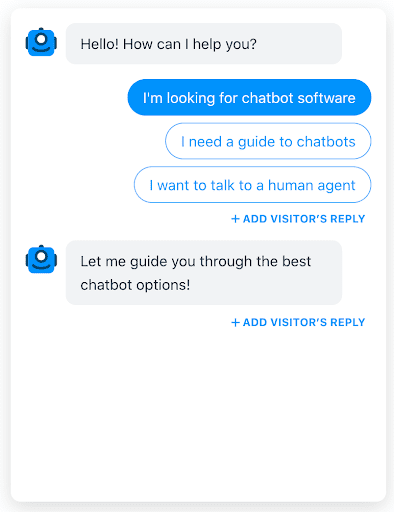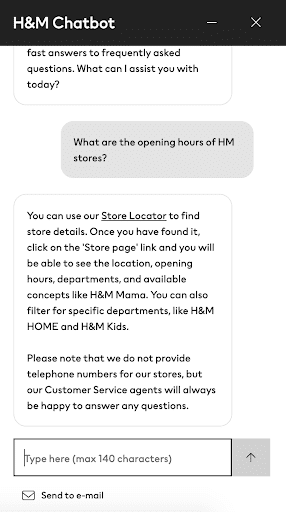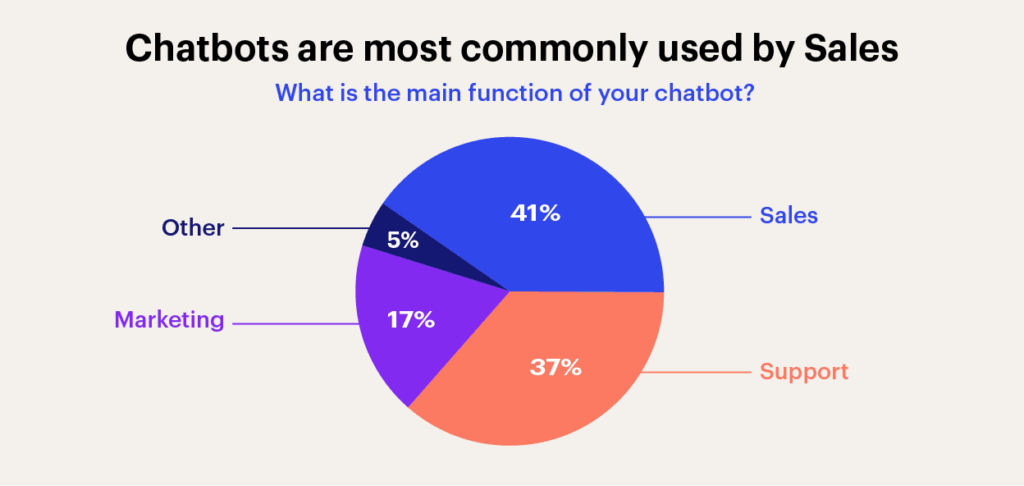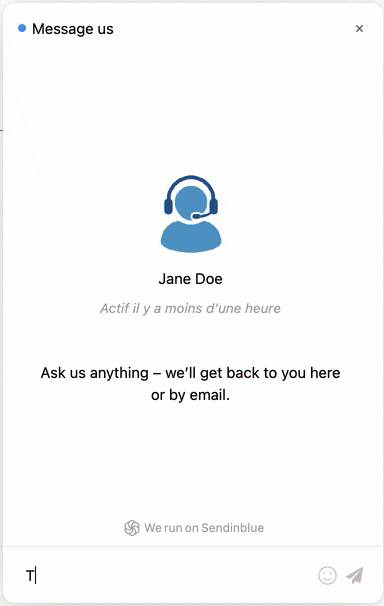You definitely interacted with them while shopping online or looking for another tool for your business. Chatbots seem to be everywhere…
… Except on your website. You haven’t implemented one yet and don’t know whether it’s worth it. You may even remember a negative experience you personally had when a non-functional bot couldn’t help you and made you go shop somewhere else instead.
So is implementing a chatbot a good idea for your business? How exactly does the technology work? Can you do it without any coding or API skills? Find the answers to all these questions in the detailed overview of chatbots below.
What is a chatbot?
A chatbot is a virtual assistant communicating with your audience via a computer program. It can proactively start chats, answer user questions, create tickets, and automate other tasks without any human intervention.

You can implement a chatbot on your website (via a live chat widget), social messaging platforms (e.g. Facebook Chatbot), or/and messaging apps (e.g. WhatsApp bot). Quality chatbot software providers let you build multichannel chatbots that provide a consistent customer experience across messaging apps and widgets.
Read more: Chatbot vs Live Chat: What’s the Difference?
Types of chatbots
There are three major types of chatbots: AI-powered chatbots, flow-based chatbots, and hybrid chatbots.
Flow-based chatbots
Despite chatbots being typically described as AI-powered virtual assistants, the majority of chatbots used by businesses are still actually flow-based.
Flow-based chatbots (also known as decision-tree or rule-based bots) handle chats according to predefined conversational flows.
How flow-based chatbots work? Flow-based chatbots are extremely easy to set up and manage. By using if/then logic and a simple drag-and-drop builder, you can design any conversation flow you want.
Here’s an example of the chatbot setup process with Brevo Conversations:

Brevo Conversations is our new chat app where you can build flow-based chatbots in a few clicks.
You set up the bot answers to the user questions you expect to receive in advance and turn the bot on. There’s no room for improvisation, the bot will follow the script. Such a setup has its pros and cons.
On one hand, you have full control over customer interactions and eliminate mistakes an autonomous AI-powered bot can make.
On the other hand, it takes a deep understanding of your prospects’ and customers’ problems to build relatable conversational paths. If you don’t have customer interaction history to pull the data from (e.g. live chat history, emails, sales calls), you won’t be able to map out chat flows that meet customer expectations.
And of course, rule-based chatbots can’t handle conversations that go beyond their predefined scenarios.
AI-powered chatbots
Artificial intelligence chatbots, or conversational AI bots, are solutions trained to operate on their own by using machine learning and natural language processing (NLP). These chatbots are able to understand the context of the message and provide users with appropriate, logical answers.

The advantage of AI-powered chatbots is that they run human-like conversations without actual human interaction other than initial setup.
How AI-powered chatbots work? They are able to learn and improve performance over time. By holding conversations regularly, AI chatbots learn to navigate conversations more effectively.
So before you launch your AI-powered bot, you need to train it to handle the most common customer queries. Your bot will learn keywords and synonyms, start understanding context and recognizing user intent to be able to provide helpful replies to customer questions.
The training process isn’t too complicated, but it’ll definitely take time before the conversational chatbot can operate adequately. This, and the need for more advanced chatbot technology solutions make many smaller businesses turn to the simpler alternative – flow-based bots.
Hybrid chatbots
Hybrid chatbots offer a mix of decision-tree chatbots and live chat. These simple yet effective solutions enable bots and humans to work together by offering seamless chatbot-human handoffs.
In a hybrid model, chatbot’s responsibilities are limited to starting conversations and answering common questions. A user can always choose to speak to a human operator to receive a personalized consultation or resolve a complex issue. Most chatbots allow for easy bot-to-human handover, enabling seamless user experience.
The setup process is very simple and straightforward: you build sequences and define scenarios when a conversation should be forwarded to an agent.

With Brevo Conversations, you can build hybrid chatbots to balance automation and human conversation.
What Is a chatbot used for?
Are chatbots only good for customer support? Definitely not.
According to the Intercom Chatbot Trends Report, chatbots are most commonly used by sales teams. Other chatbot use cases include marketing, customer service and support, onboarding, and feedback collection.
Discover chatbot examples to inspire you.

Chatbots for marketing
There are plenty of scenarios where chatbots can be useful for marketing. As a marketing tool, chatbots can:
- Announce new products and offers
- Share news and updates
- Educate customers about the product
- Automate and support multichannel marketing campaigns
- Follow up with cart abandoners
- Upsell and cross-sell
- Improve brand reputation
Highlight on Upsells and Cross-sells
Using chatbots for upselling and cross-selling is particularly effective in ecommerce.
A chatbot can proactively identify and offer relevant products based on the user search history. AI chatbots can do that better than rule-based chatbots since they can collect customer data in real-time and provide highly personalized recommendations.
Chatbots for sales
60% of businesses using chatbots are B2C. Chatbots help move potential customers through the sales funnel by recommending products, guiding through the payment process, assisting with pain points when making a purchase.
But chatbots can be a powerful sales channel for B2C brands, too. They’re capable of running entire lead generation campaigns on their own:
- Promote lead magnets to grab a website visitor’s attention
- Capturing leads with embedded forms
- Nurturing leads with automate flows and targeted messages
- Booking appointments
- Qualifying leads
- Even running product demos right within chat widgets
Chatbots for onboarding
SaaS companies often use chatbots to offer self-service onboarding to new users.
Here are just a few tasks chatbots usually offer their assistance with:
- Setting up a new account
- Navigating product features
- Upgrading
- Highlighting rules and policies
- Troubleshooting
The easiest way to guide new users through your product with a chatbot is by integrating your chatbot platform with your knowledge base. Whenever someone has a question about your product, a chatbot will pull the answer from a knowledge base and communicate it through a chat widget.
Chatbots for customer service and support
Customer support has been ranked as the second most important chatbot function (37% of cases). Indeed, when customers have a problem, it’s easiest to ask for help directly via live chat. Customers enjoy how quickly they can get assistance and how they don’t need to hunt down a support email address.

A hybrid model allows customer service agents to offer 24/7 support and handle simple problems automatically. If a chatbot can’t resolve an issue, the request can be forwarded to a human agent in real-time or converted into a ticket for further investigation.
Chatbots for collecting feedback
A chat widget can also automatically gather feedback from your customers. All you need to do is embed a survey or a feedback form into your chat flows.
While users tend to ignore elements like popups and sticky banners, chat widgets are still hard to ignore. Chatbot solutions offer a range of advantages over other methods of collecting feedback:
- They attract attention with genuine, human-like messages.
- They keep customers engaged by sharing questions one by one.
- They don’t redirect users to a dedicated survey page.
That’s why customer service chatbots are a soft but reliable tool for gathering customer feedback.
Discover the best chatbot software compared.
The Benefits of Using a Chatbot
Sales, marketing, and customer service teams use chatbots for a number of reasons. We’ve highlighted the six most significant benefits a chatbot solution can bring to a business of any size.
1. Drive user engagement
Chatbots proactively engage website visitors and increase user interaction. For example, you may be just browsing Gong’s site, but then you see this:

It’s hard to resist the temptation to click on that button, right? This is how the conversation starts.
By sending proactive messages, chatbots get users’ attention and start exchanges that often turn into sales opportunities.
2. Improve brand reputation
You have to agree that Gong’s chatbot is an awesome idea. You’re likely to remember it for a long time. This experience creates a positive brand perception, moving prospects one step closer to conversion.
But setting up a funny welcome message isn’t the only way to improve your brand reputation with a chatbot.
In today’s fast-paced world, people will appreciate it if you simply respond promptly and accurately to their questions. We all like brands that value our time and make an effort to help.
3. Automate time-consuming tasks
Chatbots can take over all repetitive questions so you don’t have to answer them again and again. They also eliminate tasks like scheduling meetings and recording lead contact details. With a proper chatbot solution, you won’t have to spend hours copy-pasting and can focus on high-impact tasks.
4. Boost customer satisfaction
Customers want fast and easy service. No wait times, straight answers to their questions, no complicated tools to use or forms to complete. Chatbots provide this direct support channel. And people will be happy to come to your site when they know the experience will be pleasant.
5. Improve employee engagement
Don’t chatbots steal customer support reps’ bread? No, quite the opposite – they help build more productive teams and boost employee engagement.
The truth is, handling loads of unqualified chats every day doesn’t make a very exciting job.
Implementing a chatbot is like hiring an assistant to support your employees’ efforts. It takes over boring, repetitive chats, enabling chat operators to handle high-level conversations where human touch is needed. Thus, they can deliver tangible results and feel accomplished.
6. Increase revenue
Prompt support and personalized customer service lead to more sales (67% more!) and higher customer retention.
Chatbots also contribute to your company’s ROI through cost reduction. “Cost savings” is one of the top 3 reasons why business leaders adopt AI chatbots.
What to keep in mind about chatbots
Too good to be true? Of course, as with any marketing tool, there are a few things to consider about chatbots before jumping in:
- You need to analyze your audience’s needs and pain points beforehand. To build conversational flows that don’t get on your customers’ nerves, you should have a deep understanding of what really matters to them and why they contact you via a chat widget in the first place.
- Your chatbot software should be easy to integrate with your CRM system. A stand-alone bot is of little help. You need it to sync with your CRM so you can record lead and customer data for further campaigns.
- It’s best to go for a multichannel solution. If you choose an all-in-one service, you not only get a built-in CRM system but also access a toolkit for running multichannel campaigns. For instance, you can set up email or transactional campaigns targeting site visitors after they’ve interacted with your chat, and vice versa.
- You still need live agents to handle complex issues. Even the most sophisticated bot can’t do it all. Treat your chatbot as a way to take the burden off your employees while they’re handling really important conversations.






